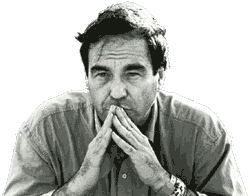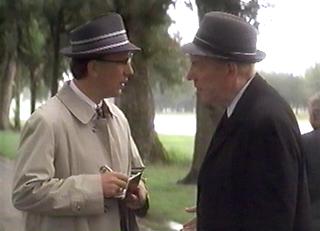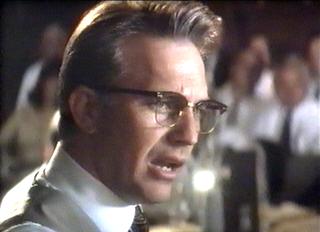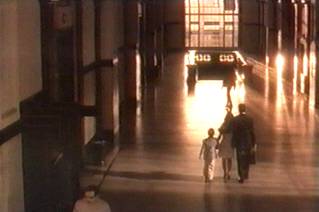 It's inherent in propaganda to tell people things that aren't true. And director Oliver Stone (right) most certainly tells his audience untruth after untruth in his very long and very didactic movie "JFK."
It's inherent in propaganda to tell people things that aren't true. And director Oliver Stone (right) most certainly tells his audience untruth after untruth in his very long and very didactic movie "JFK."
But if you are a talented director, and if you have a huge budget, you'll also try to persuade your audience with compelling visual images. The most famous example of this is Leni Riefenstahl's "Triumph of the Will," but all good movies, whether done in a noble cause or a bad one, will exploit visual imagery. That, after all, is part of the definition of a good movie.
This page presents some of the visual images of "JFK," and explains how Stone had to mislead, finagle, and withhold information from his audience in order persuade them that there was a conspiracy to kill John Kennedy. Stone doubtless felt that convincing people of this was a "good cause." But truth usually favors good causes. What does it say when, in order to promote your agenda, the truth doesn't suffice?

 As evidence that Clay Shaw worked for the CIA, Stone has Garrison
brandish a clipping from an "Italian newspaper" which links Shaw to a
Rome-based trade organization, the Centro Mondiale Commerciale (CMC, or
"World Trade Center" in English). This clipping also alleges that both
the CMC and its Swiss-based parent corporation, Permindex, were CIA
fronts.
As evidence that Clay Shaw worked for the CIA, Stone has Garrison
brandish a clipping from an "Italian newspaper" which links Shaw to a
Rome-based trade organization, the Centro Mondiale Commerciale (CMC, or
"World Trade Center" in English). This clipping also alleges that both
the CMC and its Swiss-based parent corporation, Permindex, were CIA
fronts.
The clipping shown is not an authentic reproduction of an Italian news story. Rather, it shows an Italian translation of a headline that appeared in the French newspaper l'Humanité. It does correctly summarize charges made by two Roman newspapers, (l'Unita and Paese Sera). What Stone does not tell his viewers is that l'Unita was the official organ of the Italian Communist Party, and Paese Sera was a Communist-sponsored paper which consistently sided with Moscow against the West. And l'Humanité was the premier French-language Communist newspaper.
Shaw was indeed on the CMC's board in the early 1960s, because the company wanted to establish a trade exhibition center in Rome very similar to the New Orleans Trade Mart, which Shaw managed. But Shaw was never secretive about his connection, listing it in his entry in Who's Who in the Southeast. Shaw, in fact, never travelled to Rome to attend any of the board meetings, due to the press of business in New Orleans. The article in question presented no evidence of a CIA connection with Permindex, and none has surfaced in the thirty-plus years since.
Stone, who prides himself on not accepting the "official story," has simply accepted Communist propaganda as true.

The problem came with the scene that was to show viewers smoke billowing out from under the trees on the Knoll as Kennedy was shot. Stone's staff searched high and low, but they could not find a rifle that would emit the required puff of smoke. Modern rifles, after all, use "smokeless" powder — which is not literally smokeless, but which doesn't send up big billows.
So Stone had a special effects man blow smoke from a bellows, as can be seen in the still at right, above. This seems an appropriate metaphor for the entire movie.

President Kennedy was killed by a conspiracy that was planned in advance at the highest levels of our government and it was carried out by fanatical and disciplined cold warriors in the Pentagon and CIA's covert apparatus, among them Clay Shaw here before you. It was a public execution.Has Stone failed to name anybody? Yes he has, but he immediately remedies that defect:
And it was covered up by like-minded individuals in the Dallas Police Department, the Secret Service, the FBI, and the White House, all the way up, including J. Edgar Hoover and Lyndon Johnson, whom I consider accomplices after the fact.Where Oliver Stone usually sanitizes Garrison, in this particular case he has Costner mouth a crackpot theory that involves a virtual cast of thousands in the murder of JFK. Although Garrison had indeed charged all those groups with involvement, his actual closing summation to the jury was more subtle and more effective. He vaguely blamed an assassination coverup on "the government" and urged the jurors to use their power to stand up to "authority."
But the Garrison summation, like the Costner-Garrison summation, said essentially nothing about the case against Clay Shaw. Stone, like Garrison before him, resorted to making a case against "the government" and trying to use it to convict Shaw.

The real Jim Garrison was not even in the courtroom when the verdict was announced. In spite of his later claims to have been at home, he was in his office, and went into a roaring tirade when he got the news from aides. The "American people don't want to know the truth about the assassination," he bellowed (Milton Brener, The Garrison Case, p. 269).
Presenting Garrison as an heroic but flawed human being would itself be a travesty, but Stone cannot concede even this much to historical reality. His Garrison is a paragon whose only minor flaw is being so consumed with a passion for justice in the JFK murder that he sometimes neglects his family. Heros like this can be the basis of great movies when presented as frankly fictional characters in the hands of a great director like the late Frank Capra. But when the real-world Jim Garrison is given this treatment, the result is a sordid, grotesque parody of movie heroism.